27 Best Product Feedback Software Tools By Category

By Dayana Mayfield
Last updated on Sun Apr 13 2025
Elon Musk once started a Twitter poll that asked users if they wanted an Edit button. Over 70% of four million users voted yes, prompting Twitter to acknowledge the need for an Edit button. Besides increasing user activity, the tweet caused Twitter’s stock value to soar briefly.
The incident proves that user feedback is still an invaluable instrument. However, Twitter is not the most effective product feedback tool. If you want a much more effective tool for gathering and analyzing product feedback, we’ve identified the best platforms for the job. Keep reading to discover the features that set these feedback tools apart from the rest.
Our categories of product feedback software tools:
Idea boards and feedback widgets
Survey tools
Product and website analytics tools
Product management software with feedback
Market research tools
Keep reading for the complete list!
Idea boards and feedback widgets
User feedback tools that offer idea boards and feedback widgets allow your customers to suggest ways to improve your website or product quality and performance. The widgets allow you to embed the feedback tool into your website or app, so users can easily access it to make recommendations. Below are the top tools that offer these features:
1. Frill

Frill is a highly rated product feedback tool that excels at simplifying hearing what your users want. It accomplishes this through a user-friendly feature suggestion and feedback software that you can embed into your app or website. Frill also comes with a roadmap and announcements tool for updating users about the actions you are taking regarding their recommendations.
Features
Feedback boards with voting and comments
Public roadmap with customizable statuses
In-app announcements and changelog
Embedded feedback widgets
Micro-surveys (NPS, CSAT, etc.)
SSO authentication and user identification
Prioritization tools (RICE, Priority Matrix)
Integrations with tools like Jira, Slack, Intercom, and Zapier
Pricing
Frill offers four pricing tiers: Startup ($25/month) includes 50 ideas and one survey. Business ($49/month) adds unlimited ideas and three surveys. Growth ($149/month) includes all features. Enterprise (from $349/month) adds SOC2, audit logs, dedicated hosting, and support.
Pros and cons
With Frill, you get a beautiful, clean user interface for all of the essential features you need for product feedback collection. The cost is one of the lowest on our list. However, as a simpler product, it might not work for large teams.
Frill costs just $25 per month and offers a free trial, so sign up and give us a try.
2. Acute
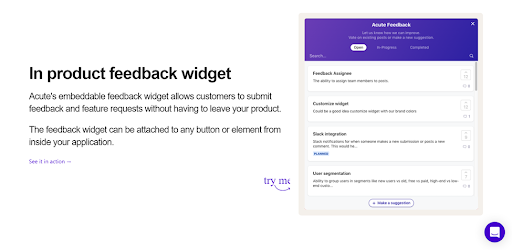
Acute offers embeddable widgets for collecting user feedback directly from your product. Your users can also submit feature requests via the widget.
Features
In-app feedback widget
Custom branding
Public and private feedback options
User identification and syncing
Feedback statuses
Feedback prioritization with RICE
Vote on behalf of users
Public roadmap
Pricing
Acute offers a free Starter plan with 20 suggestions and one team member. Growth is $25/month for 1,000 suggestions and two team members. Business ($50/month) supports 2,500 suggestions and unlimited users. Enterprise ($99/month) includes unlimited suggestions and team members.
Pros and cons
Acute offers all of the basic feedback features you need, including widgets, statuses, and notifications. However, it doesn't offer advanced features or integrations.
3. AnnounceKit
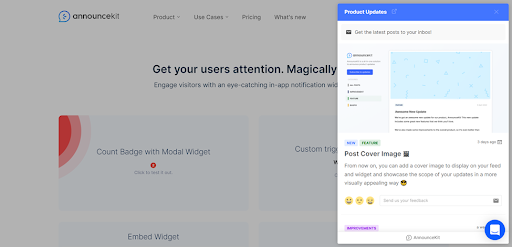
AnnounceKit can help you with announcing product updates to users. You can also use the tool to collect feedback and gain insights into user reactions to your updates.
Features
Notification widgets for in-app announcements
Feature request collection and voting
Boosted announcements for increased visibility
Public product roadmap
Emoji reactions and user comments for feedback
Email and Slack notifications
User segmentation for targeted messaging
AI-powered writing assistant for announcement creation
Pricing
AnnounceKit pricing starts at $79/month for Essentials. Growth ($129) adds segmentation and feature requests. Scale ($339) includes advanced security and multi-language. Enterprise starts at $599/month annually. All plans include a 15-day trial except Enterprise.
Pros and cons
Like the name suggests, AnnounceKit is all about feature announcements. And while there are some basic feedback collection options, those aren't as robust as others on the list. This product might be a good fit for you if you already have a feedback tool and need better release notes and notifications.
4. FeatureOS
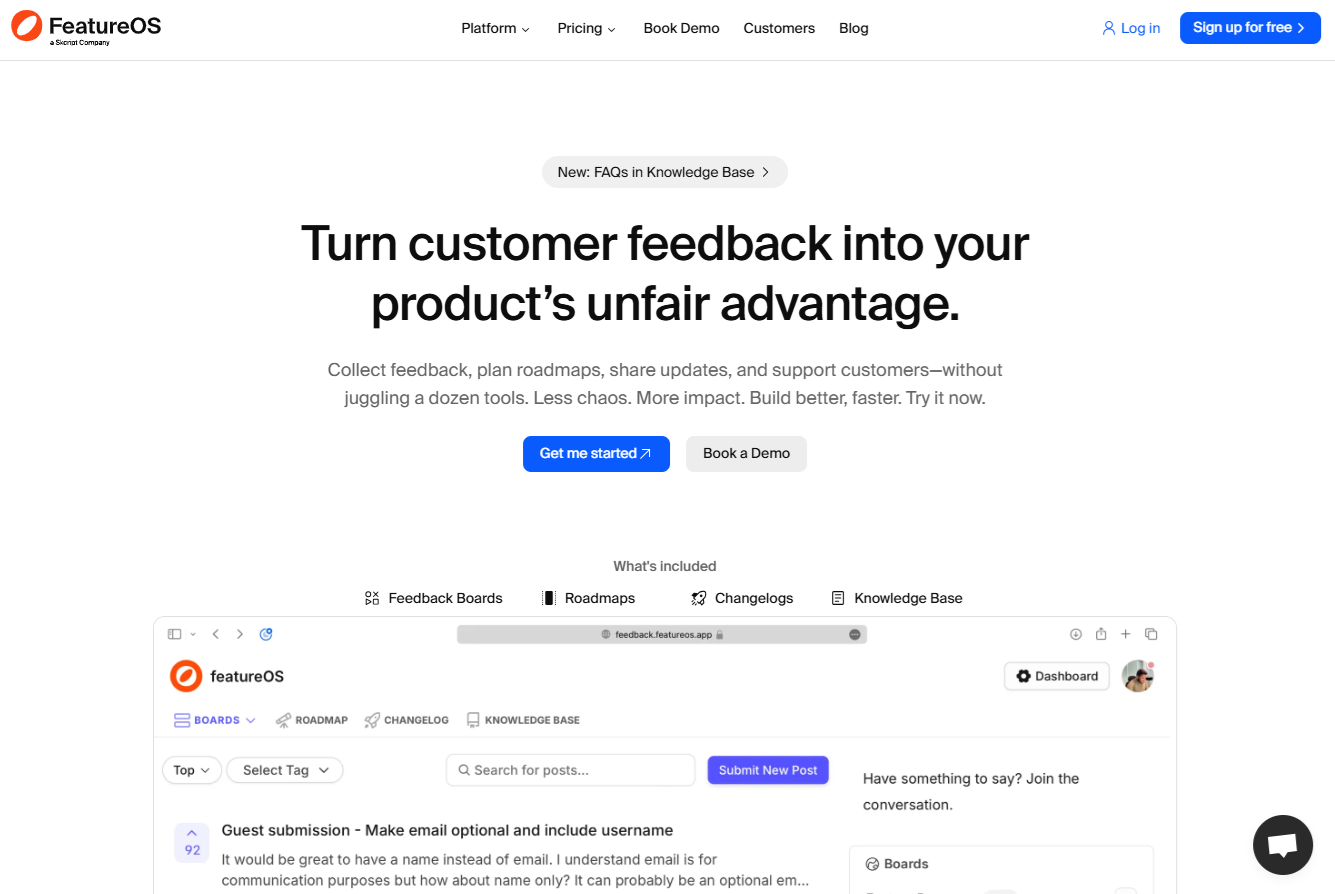
FeatureOS provides a single location where you can gather and analyze user feedback. Besides public feedback boards for collecting insights from everyone, Hellonext offers private feedback boards for collecting suggestions from specific individuals.
Features
Feedback boards (public or private)
Visual product roadmaps
Changelogs with pop-up widgets
Self-service knowledge base
AI assistant “Kal” for writing and insights
Automated feedback and roadmap updates
Email notifications for new releases
Multiple integrations with product tools
Pricing
FeatureOS pricing starts at $60/month for Starter, $120 for Growth, and $250 for Business. All plans include feedback boards, roadmaps, changelogs, knowledge base, and AI features. Enterprise, nonprofit, and education discounts are available on request. 14-day free trial included.
Pros and cons
FeatureOS offers a powerful AI assistant, a rich suite of features, including feedback boards, roadmaps, changelogs, and a knowledge base, and flexible pricing that makes it an appealing all-in-one platform. However, it lacks more robust product management capabilities, which may limit its usefulness for teams needing deeper planning or execution tools.
5. Upvoty
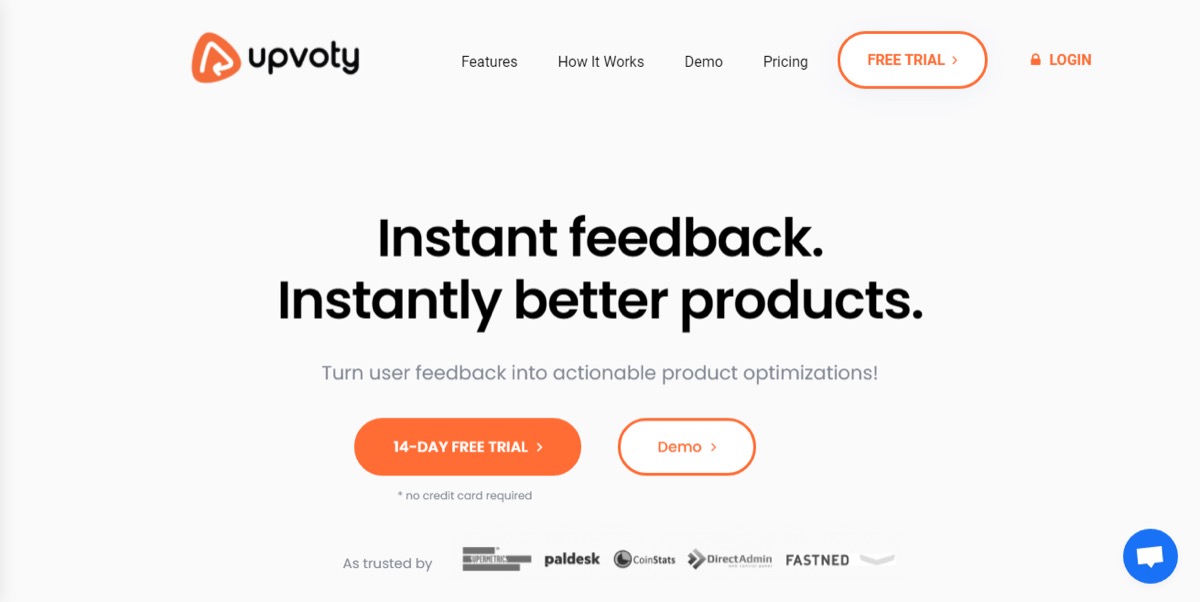
Upvoty offers feedback portals and boards that collect feature requests and allow users to upvote or downvote suggestions. You can use widgets to embed the feedback portal into your website.
Features
Feedback boards with voting and status updates
Customizable public or private product roadmaps
Changelog with customizable release feeds
Widgets to embed boards, roadmap, or changelog
User SSO and anonymous participation
AI-powered duplicate post detection
Post moderation and team member assignment
Custom domains, tags, and board organization
Pricing
Upvoty pricing starts at $15/month for Power (1 project, roadmap, custom domain). Super is $49/month with integrations and custom boards. Hyper is $99/month with 3 projects, all integrations, custom SSO, and CSS. All plans include unlimited boards, users, and a 14-day free trial.
Pros and cons
Upvoty gives you product feedback software, product roadmaps, and a changelog all in one place. The pricing is affordable for small businesses, but they don't have the advanced security and integration features that enterprise companies might expect.
6. Savio
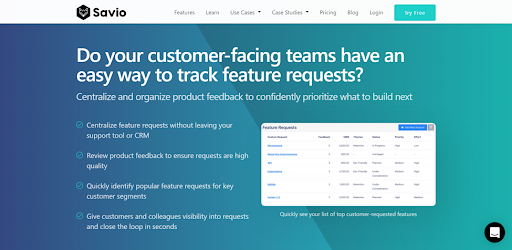
With Savio, you get a lot of integrations that make it easy to track product feedback and feature requests from a bunch of different sources. You can also setup a feature voting board to take new requests and offer upvoting.
Features
Centralize feedback from tools like Intercom, Zendesk, Slack, and email
Categorize verbatim customer feedback into feature requests
Prioritize features using customer data (e.g., revenue, plan, lifecycle stage)
Create public, private, or internal voting boards
Sync status with dev tools like Jira and Shortcut
Segment feature requests by product, customer type, or source
View and manage requests directly inside CRM Software and tools like HubSpot and Salesforce
Close the loop with personalized feedback update emails to customers
Pricing
Savio pricing starts at $39/month for Essential, $79 for Professional, and $249 for Business. Each includes one paid user, unlimited free users, and increasing access to integrations, roadmaps, CRM data, and segmentation. All plans include a 14-day free trial.
Pros and cons
Savio is good if you have product feedback coming from a lot of different sources. However, if you want to train your customers to give you feedback in a central idea board, you can do so with a more affordable solution like Frill.
7. Nolt
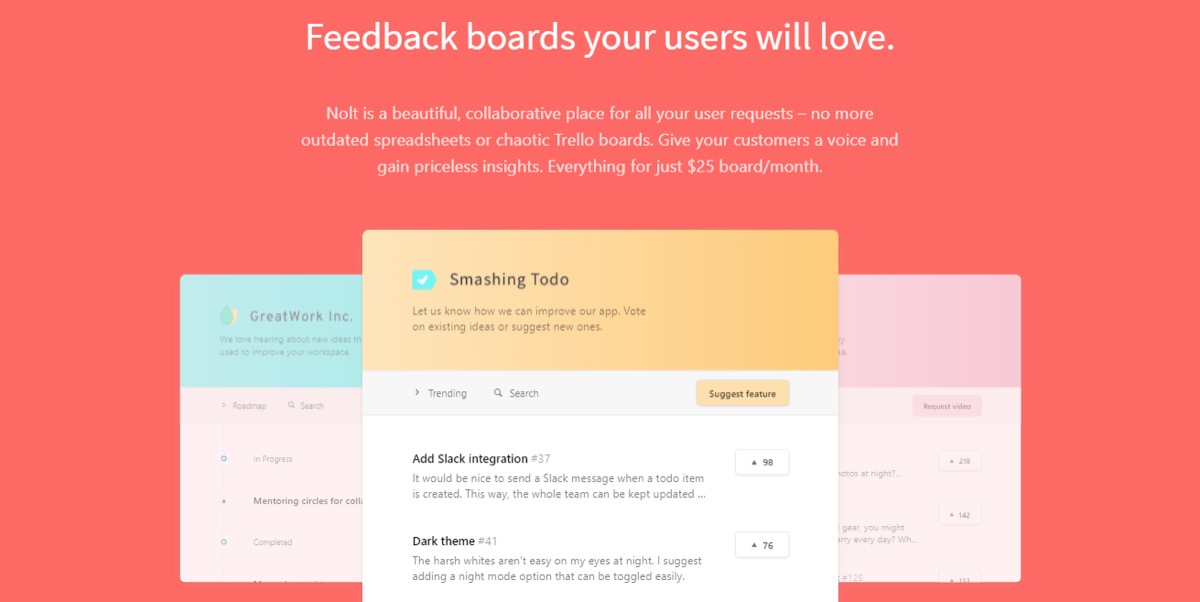
Nolt is a simple product feedback software that lets you create feedback boards where customers can submit feedback and vote on each others' ideas.
Features
Customizable public or private roadmaps
Custom statuses and fields to match your workflow
Duplicate detection and suggestion merging
Private/internal notes and manual moderation
Password-protected and SSO-enabled boards
Website widget and custom branding options
Status updates and automated email notifications
Slack, Intercom, and webhook integrations
Pricing
Nolt offers flat-rate pricing with unlimited users and admins. Essential is $29/month (annually) for 1 board and core features. Pro is $69/month with 5 boards, advanced integrations, and moderation tools. Enterprise offers unlimited boards, SSO with SAML, priority support, and custom invoicing, pricing available on request.
Pros and cons
Nolt offers feedback collection and public roadmapping, but you don't get a changelog or announcement roll. So you'll need to layer on a separate software to keep your customers informed when you update your product. This can make for a messy workflow. However, the low pricing might be worth it to you.
8. UserVoice
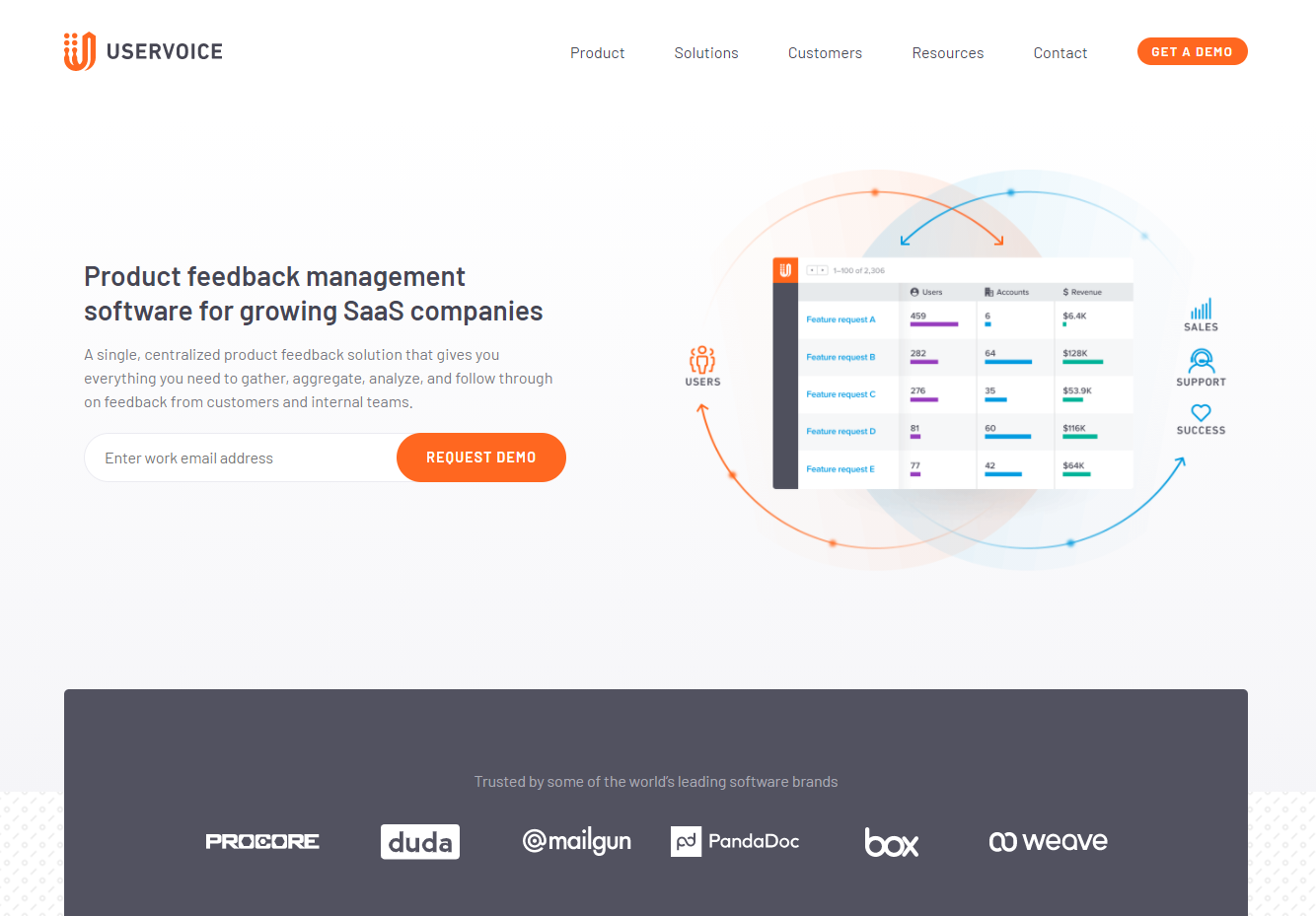
UserVoice is a more robust product feedback software. You can use it to not only collect product feedback but to also manage product strategy, align with your internal team, and announce product updates.
Features
Product feedback collection from users via web portals
Continuous product discovery with data-driven insights
Prioritization tools focused on identifying problem spaces, not just feature ideas
Customer engagement tools for responding to feedback at scale
Roadmap alignment to highlight opportunities and track progress
Smart integrations with tools like Zendesk, Salesforce, and Slack
Internal team alignment using shared insights and collaboration features
Custom reports and analytics to inform product strategy and decision-making
Pricing
UserVoice pricing starts at $899/month for Growth, $1,199 for Team, and $1,349 for Strategic, each with increasing feedback volume, collaboration, and analytics features. Enterprise plans offer advanced security, support, and scalability—pricing available on request. All tiers include feedback collection and user segmentation tools.
Pros and cons
UserVoice might be worth the heavy price tag if you have a lot of product managers on your team that are struggling to get aligned internally. However, you can collect feedback on your current product and in-progress roadmap with more affordable solutions mentioned here.
9. UserReport

UserReport offers a variety of features to help you build more engaging products that customers love. You'll get a feedback widget and a survey widget to help you collect a variety of different types of product feedback.
Features
Survey widget for collecting user insights
Feedback widget for gathering feature ideas and bug reports
Net Promoter Score (NPS) tracking with demographic segmentation
Demographic data collection to understand your audience
User voting system to prioritize ideas
Google Analytics integration for enhanced behavioral insights
Customizable and multi-language widgets (60+ languages supported)
Premium reporting tools for publishers and advertiser sales kits
Pricing
UserReport doesn't publish their pricing, so you'll need to contact sales for a custom quote.
Pros and cons
Unlike others on our list, UserReport is designed for websites whose content is their main product. It's a fit for digital publishers, magazines, and bloggers. The Google Analytics integration can help you analyze your feedback and website analytics in one place. However, the high enterprise costs means it's probably only a fit for large companies.
Survey tools
Survey tools are product feedback tools that gain insights through survey forms filled out by your users. These tools automate most of the survey creation, collection, and analysis process to help you gain user insights quickly and efficiently. Some of the best user feedback tools that rely on surveys include:
10. Typeform
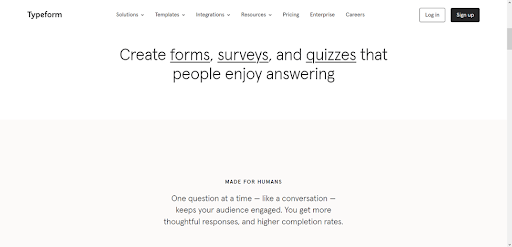
Typeform offers a simple way to create surveys, polls, and other forms for learning what your users want. The platform optimizes every feedback form to ensure users respond and provide accurate answers.
Features
Customizable, branded form design
Interactive forms, surveys, and quizzes
Conditional logic for follow-up questions
Video embedding for more engaging forms
AI-powered data analysis and insights
Pre-filled hidden fields for seamless data collection
300+ integrations with tools like Slack, HubSpot, and Google Sheets
Access to 3,000+ form templates
Pricing
Typeform pricing starts at $25/month for Basic, $50 for Plus, and $83 for Business, with increasing response limits and features. Enterprise plans are custom-priced. All plans include unlimited forms and questions, with discounts available for annual billing. A free plan is also available.
Pros and cons
If you don't like Typeform's classic "one at a time" survey style, then you should choose another option on this list. Otherwise, you can't go wrong with Typeform's many templates and integrations.
11. Feedbackify
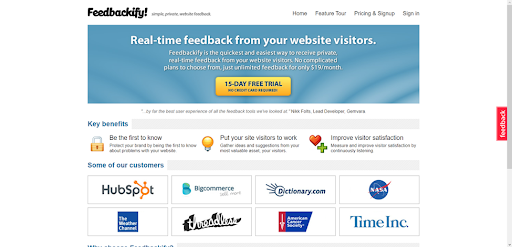
Feedbackify provides user feedback forms for collecting real-time insights from your website users. It takes just five minutes to create an account and integrate Feedbackify with your website.
Features
Customizable feedback form with rating question
Drag-and-drop interface for adding feedback categories
Upload company logo for branded form experience
Customizable website feedback tab
Option to launch form via text link
Simple HTML embed for easy deployment
Real-time feedback dashboard
Contextual data capture (page, location, browser, OS, screen size)
Pricing
Feedbackify only costs $19 a month, and you can collect feedback from unlimited users.
Pros and cons
Feedbackify offers a low price tag, but the UX is very outdated, so it might not offer the customer experience that you're looking to deliver to your audience.
12. ProProfs Qualaroo
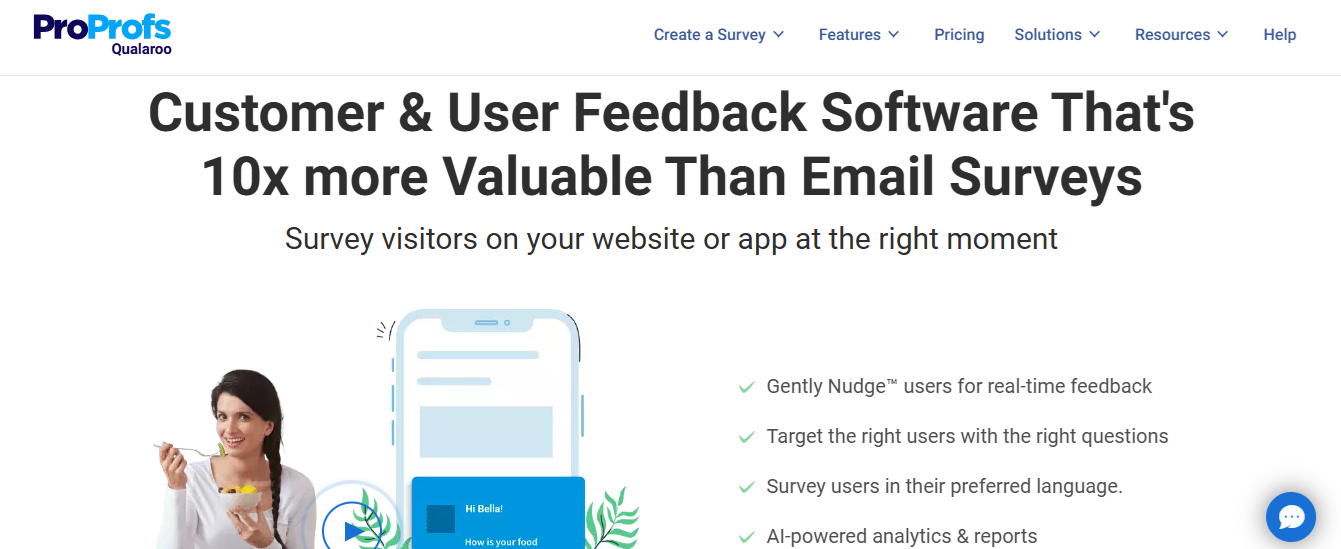
Qualaroo offers several ways to collect user feedback, but its most widely used tool is its survey form. The platform provides several survey templates, allowing you to choose and adapt the one that best fits your needs.
Features
AI sentiment analysis
Question branching and logic
Mobile in-app nudges
Advanced user targeting
Exit intent surveys
Prototype testing with Nudge for Prototype
A/B testing support
Custom branding and design options
Pricing
Qualaroo offers a free plan with up to 50 responses. Paid plans start at $19.99/month (Essentials), $49.99/month (Business), and $149.99/month (Enterprise, annual only). All plans include surveys via email, web, and in-app, with increasing features like targeting, integrations, and mobile SDK access.
Pros and cons
Qualaroo has a ton of different ways to collect feedback—too many for most small businesses. But if you're in an industry other than software, you might enjoy all of the different options.
13. Jotform
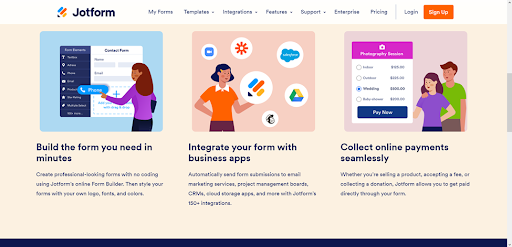
Jotform is a fast solution for building survey forms for user feedback and suggestions. You can integrate survey forms with your site or SaaS apps your team uses.
Features
No-code form builder with full design customization
Conditional logic for dynamic, personalized forms
Online payment collection through major gateways
150+ integrations with CRMs, email tools such as cold email software, cloud storage, and more
AI-powered form and response automation tools
Report generation and data visualization
Mobile-friendly forms and offline data collection
E-signature support for contracts and approvals
Pricing
Jotform offers a free Starter plan, with paid plans starting at $34/month (Bronze), $39/month (Silver), and $99/month (Gold). Enterprise plans are custom-priced. All plans include core features, with higher tiers offering more submissions, storage, signed documents, and advanced functionality.
Pros and cons
Jotform offers so many integrations that you can certainly find another use case for it besides collecting feedback, which will help it pay for itself. However, it doesn't offer feedback management, comments, or upvoting.
14. SurveySparrow
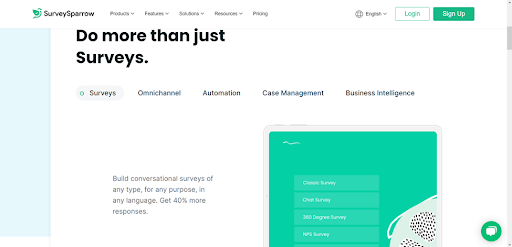
SurveySparrow offers online and offline surveys for learning how your customers want you to improve. One of its most impressive tools is its Chatbot for Website, which uses AI to engage users and collect accurate feedback.
Features
AI-powered insights with CogniVue
Conversational surveys for higher response rates
Multichannel feedback collection (email, WhatsApp, web, etc.)
Reputation management across 100+ review platforms
Built-in ticketing system for service recovery
SpotChecks for contextual micro-feedback
2000+ integrations with CRMs and automation tools
AI assistant “Wings” for survey creation and review response
Pricing
SurveySparrow offers a free plan and paid plans starting at $19/month (Basic), $39 (Starter), $79 (Business), and $249 (Professional), billed annually. Enterprise plans are custom. All plans include surveys, with higher tiers adding branding, workflows, multilingual support, and advanced analytics.
Pros and cons
SurveySparrow is a robust platform that can be used by customer experience, product experience, employee experience, marketing experience, and sales experience managers. However, as an enterprise solution, it's not a fit for most businesses.
15. Paperform

Paperform is similar to Jotform in that it offers online forms that can be used for a variety of purposes, everything from leads to feedback collection to orders and payments. You can even add images and videos to your forms to make them more engaging and informative.
Features
No-code form builder with advanced customization
Built-in eSignature tool (Papersign)
Integrated scheduling and booking management
Payment collection with Stripe, PayPal, and Square
Powerful calculations and conditional logic
Guided Mode for conversational form experiences
3,000+ integrations via native apps and Zapier
Advanced theming and branding controls for seamless design
Pricing
Paperform offers four plans: Essentials at $24/month, Pro at $49/month, Business at $99/month, and custom-priced Enterprise. All plans include unlimited forms, with increasing limits on responses, users, payments, and advanced features like custom domains, branding, automation, and API access. Free 7-day trial included.
Pros and cons
Paperform is priced right for small businesses, and you can use it for many other things besides customer feedback collection. But you'll need a separate system to help you sort, prioritize, manage, implement, and respond to that feedback.
Product and website analytics tools
Product analytics tools provide insights regarding how your customers interact with your website or app. You can use this information to improve the user experience of your platform to ensure customer satisfaction. Below are some of the best analytics tools for getting user feedback:
16. Mixpanel
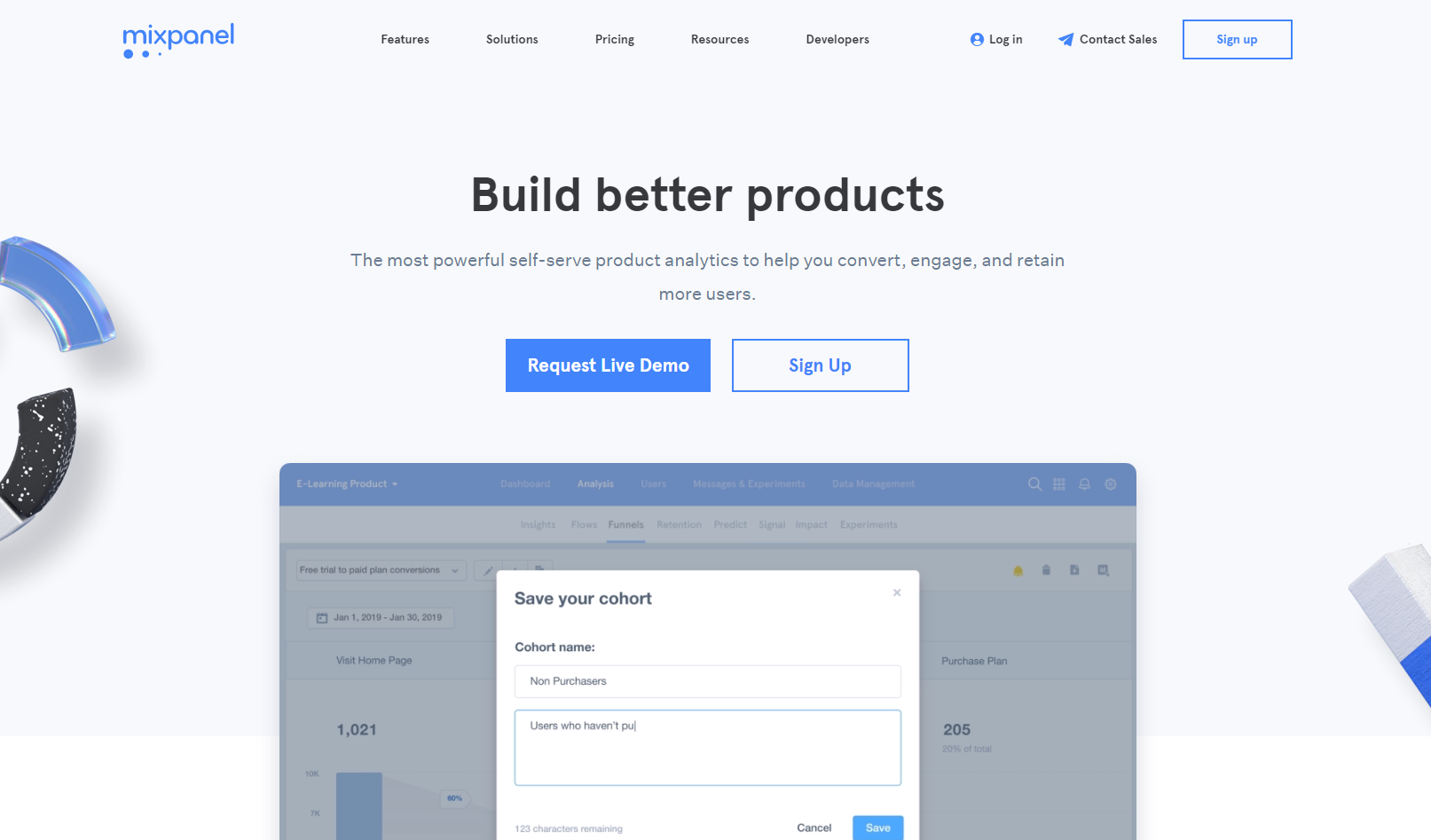
Mixpanel is a self-serve analytics tool that provides insights you can use to modify products and achieve higher user conversion, engagement, and retention. The platform accomplishes this by providing accurate reports regarding who uses your app or website and how they use it.
Features
Product analytics for tracking user behavior and engagement
Session Replay to watch real user journeys
Self-serve dashboards for instant insights without SQL
Native warehouse connectors for trusted data sync
SDKs for direct data streaming from any product
CDP integrations (e.g., Segment) for easy data flow
Cross-team data unification on one platform
Real-time tracking of user acquisition, retention, and growth
Pricing
Mixpanel offers a free plan with 1M monthly events and 10K session replays. Growth starts at $0 with pay-as-you-go pricing after 1M events ($.00028 per event). Enterprise includes unlimited events and advanced features. Startups get their first year free if eligible. No credit card required.
Pros and cons
Mixpanel is widely regarded as the best analytics solution for software companies and other digital products. If that's not you, consider one of the other options in this category.
17. Hotjar
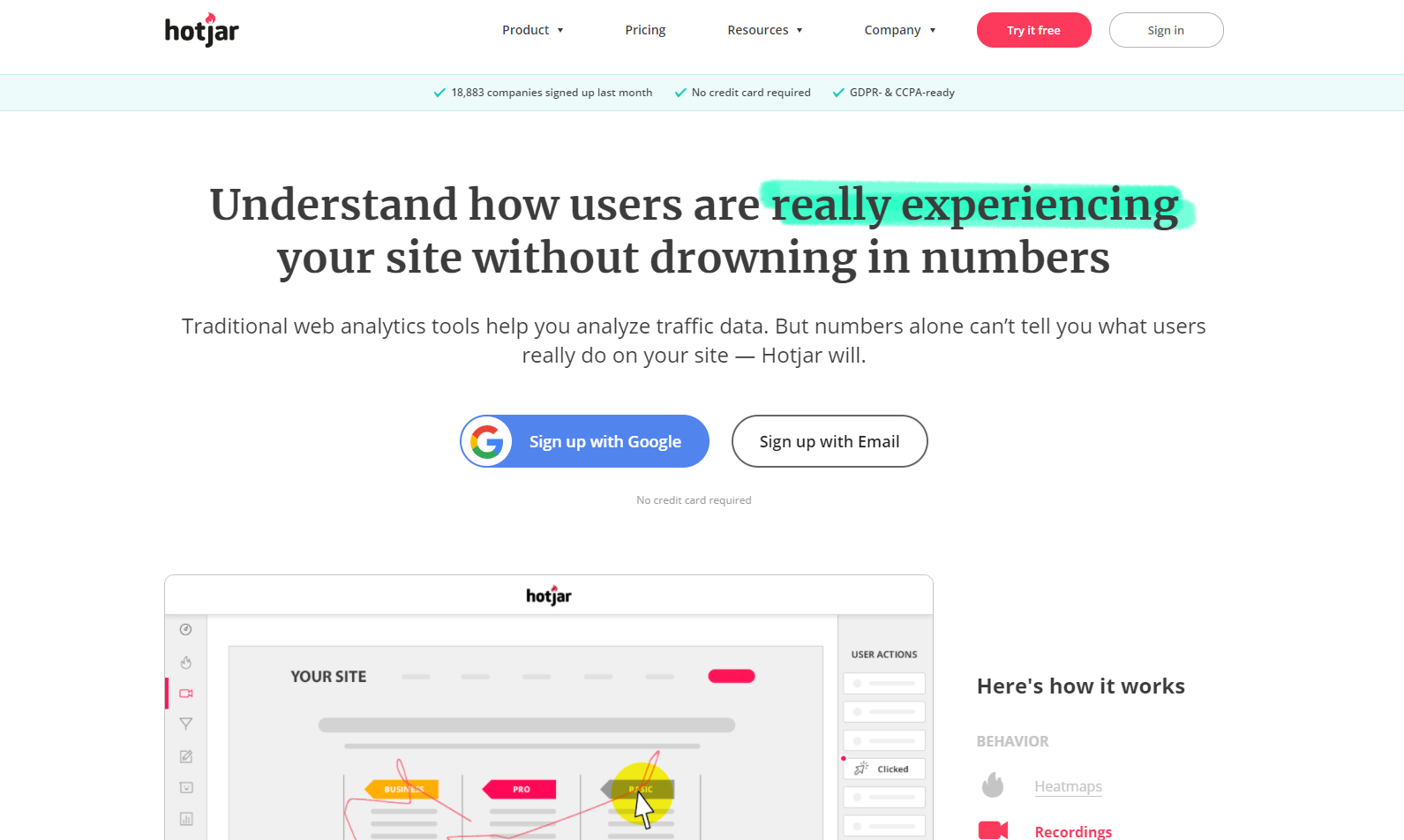
Hotjar records what your users see when they use your product. You can review the recording to learn how users interact with your tool. Hotjar also provides heatmaps – a valuable tool that reveals the parts of your platform that users interact with the most. You can use the information to improve the less-used aspects of your product.
Features
Heatmaps to visualize user interaction
Session recordings of real user behavior
On-site feedback widgets for instant reactions
Customizable surveys to gather user insights
User interviews for qualitative research
AI-powered behavior insights
Integration with tools like GA, Slack, and Zapier
Funnels and trends for analyzing conversion paths
Pricing
Hotjar offers free plans for Heatmaps, Surveys, and Interviews. Paid plans start at $32/month (Observe), $48/month (Ask), and $39.20/month (Engage). Business and Scale tiers offer more sessions, responses, and advanced features like funnels, API access, and SSO. Bundle discounts and annual billing are available.
Pros and cons
Hotjar can be used in a variety of industries, but they really shine in the ecommerce space. If that doesn't describe your company, you can still get value out of this platform if you have a B2C business and want feedback on your website. But if you're looking for feedback on specific products, this isn't the platform for you.
18. Mouseflow

Like Hotjar, Mouseflow records the user journey and provides insights about the parts of your website users use the most or avoid. You can use the information to optimize your website user experience to boost engagement, conversions, and customer retention.
Features
Session replay to watch real user journeys
Heatmaps for clicks, movement, and scroll behavior
Funnel analysis to detect where users drop off
Form analytics to identify friction and abandonment
User feedback collection through surveys
Journey mapping for full-path visualization
Automatic Friction Scores to highlight usability issues
30+ integrations with tools like CMS, analytics, and marketing platforms
Pricing
Mouseflow offers a free plan with 500 sessions/month. Paid plans start at $31/month (Starter), $109 (Growth), $219 (Business), and $399 (Pro), with increasing session limits, data retention, and features. Enterprise plans are custom. All plans include heatmaps, session replays, and journey analytics.
Pros and cons
With Mouseflow, you can uncover the reasoning behind some trends in your Google Analytics data, which is great for knowing what people think of your product pages. However, to collect feedback on your product itself, try one of the other categories on our list.
19. UserInput
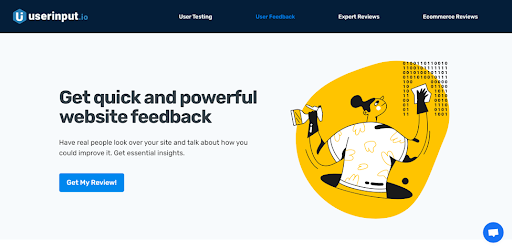
You can use UserInput to measure the site navigability and user experience of your ecommerce site. The tool works by recording users interacting with your site and assigning experts to identify areas for improvement.
Features
Customer feedback videos from real people in your target market
Unfiltered insights to identify friction and usability issues
User testing to find where visitors get stuck or confused
CRO audits with expert action plans for optimization
Easy-to-launch research projects with minimal setup
Eye-tracking heatmaps to visualize user attention
Personalized recommendations to improve conversions
Fast turnaround for actionable, high-quality feedback
Pricing
UserInput pricing starts at $149 for 3 reviewers, $249 for 5, and $399 for 10. All plans include demographic targeting, project design assistance, and a 100% satisfaction guarantee, with results delivered in 3–10 business days depending on package size.
Pros and cons
UserInput is great for briding the worlds of product feedback software and website software. You can collect feedback on both your site and your products. Collect specific comments and videos from website users, as well as average stats on what people are most attracted to. The platform isn't a fit outside of the ecommerce industry, however.
20. Amplitude
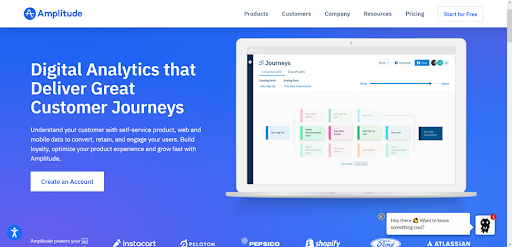
Amplitude provides actionable insights regarding all aspects of your digital product and customer experience. You can use the data to improve your understanding of customer behavior and optimize your product to outperform competitors.
Features
Advanced product analytics to understand user behavior
Behavioral cohorts to track and segment customer groups
A/B and multivariate testing to optimize product decisions
Real-time data streaming and syncing for instant insights
Session replay to see exactly how users navigate your product
Feature flags and experimentation tools to test new features safely
Activation tools to create and deliver personalized experiences
Predictive analytics to identify growth opportunities before they happen
Pricing
Amplitude offers a free Starter plan for up to 50K monthly tracked users. Paid plans start at $49/month for Plus, with advanced analytics and feature management. Growth and Enterprise plans offer custom MTU volumes, predictive insights, and premium support—scaling with your business needs.
Pros and cons
Amplitude is a great product analytics platform for software and other digital products. It can also be used by corporate website experience teams. But, it doesn't have much to offer outside of these industries, and it is designed for enterprise companies.
Product management software with feedback
These platforms offer feedback collection inside of software designed for product managers. PM tools typically offer roadmapping, and might also include features for bug testing, feature prioritization, in-product guides and walkthroughs, NSAT score collection, and more.
21. Pendo
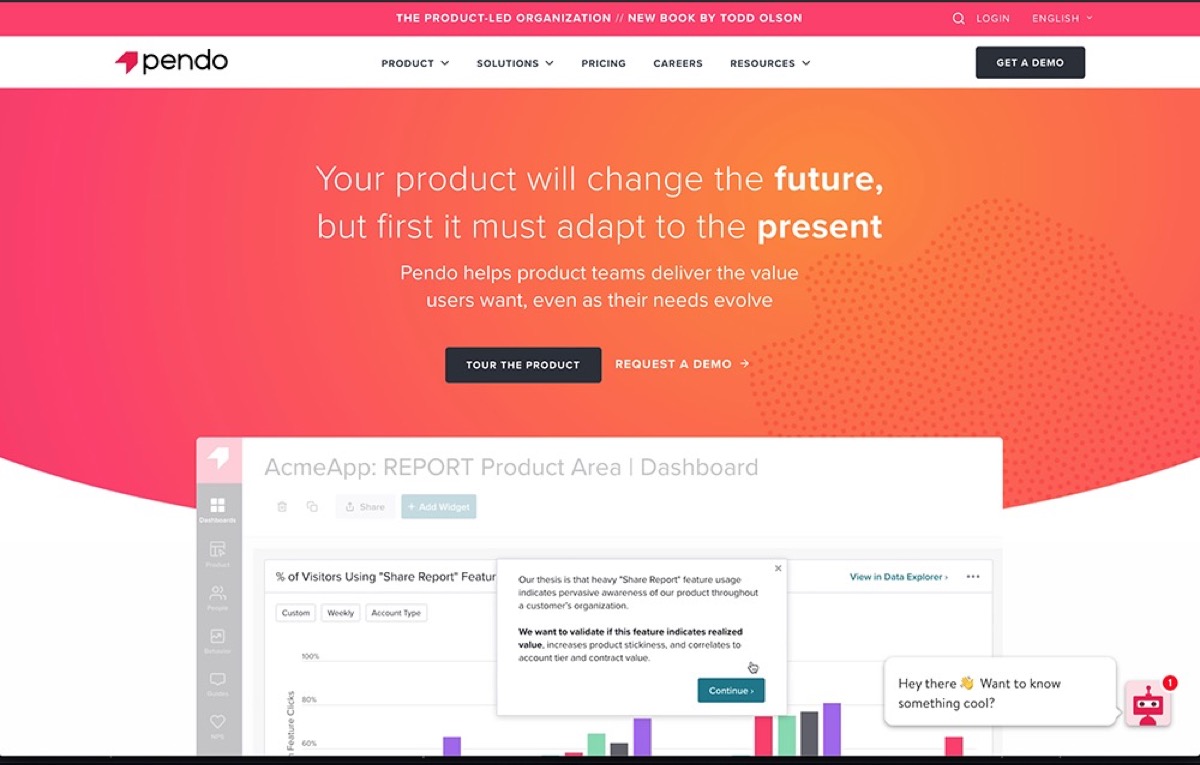
Pendo is a great fit for product teams that want to combine user onboarding with product feedback. It opens up communication between product managers and users for a very tight feedback loop.
Features
In-depth product analytics to understand user behavior
No-code in-app guides for user onboarding and engagement
Session replay to visualize user interactions
NPS and sentiment tracking to capture customer feedback
Pendo AI for predictive insights and intelligent recommendations
Multi-channel orchestration for targeted communication
Roadmaps and feedback collection for product planning
Enterprise-grade security and compliance (SOC2, GDPR, ISO 27001)
Pricing
Pendo offers flexible plans based on monthly active users. The Base plan includes core analytics and guides. Core adds session replays. Pulse includes NPS and product discovery. Ultimate adds advanced orchestration and data sync. A forever-free plan supports up to 500 users. Pricing is custom.
Pros and cons
While Pendo is free for up to 500 MUAs, the price tag is really steep for their lowest plan, meaning this won't be a fit for most SaaS companies. If you can afford it or you're scaling quickly, go for it. The all-in-one aspect might be worth the cost, especially if multiple teams can get value from it.
22. ProductBoard
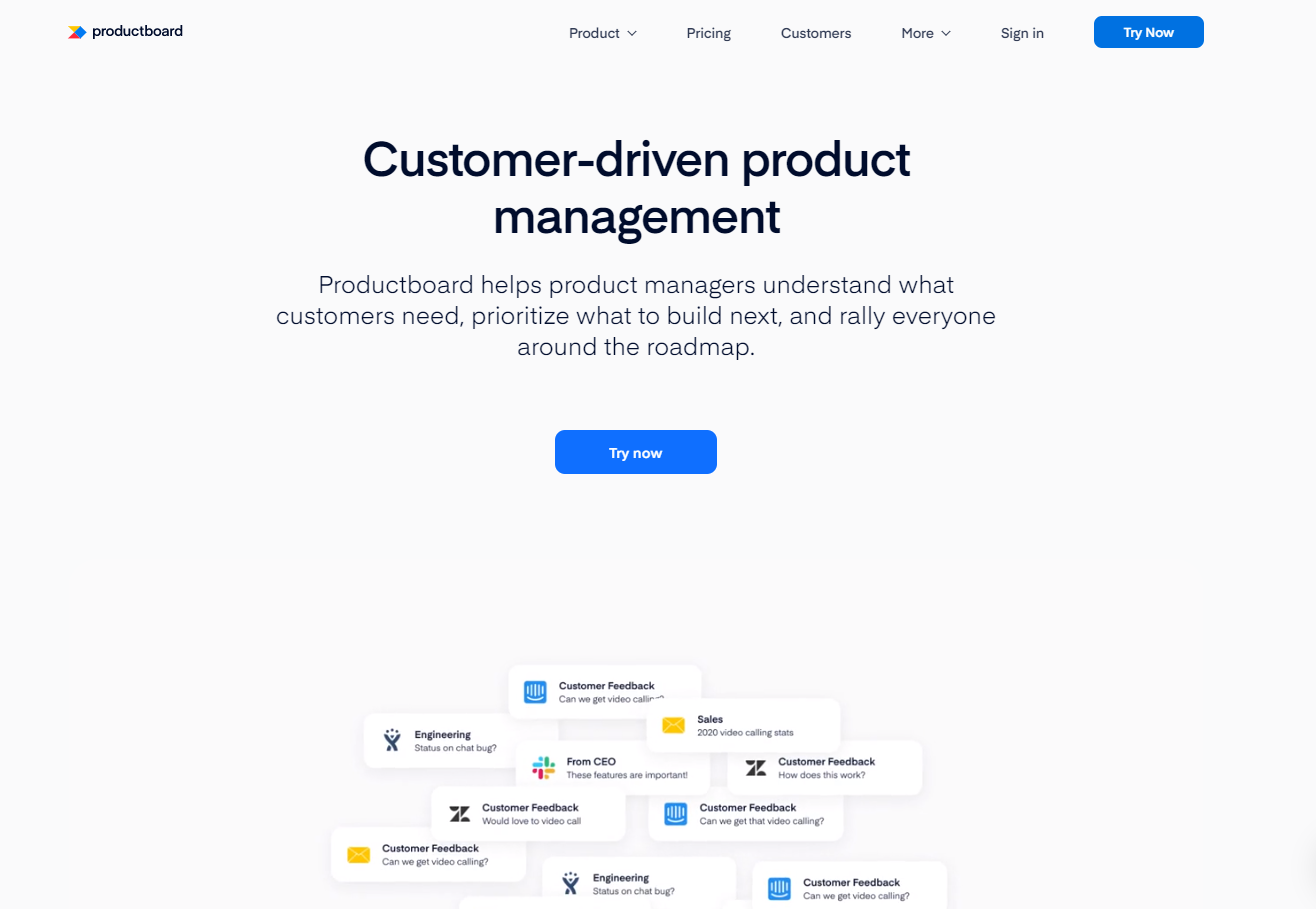
ProductBoard is a classic, tried-and-true platform for product managers. You can centralize feedback, validate your ideas, and build roadmaps that are public or private.
Features
Collaborative roadmapping with real-time updates and progress tracking
Centralized customer feedback to uncover trending needs
AI-powered insights to analyze feedback and accelerate workflows
Prioritization frameworks to build what matters most
Visual, interactive roadmaps for stakeholders
Feedback inbox and insights board for organized product discovery
Customizable product hierarchy for scalable planning
Integration with tools like Jira, Salesforce, Slack, and more
Pricing
Productboard offers a free Starter plan, Essentials at $19/maker/month, and Pro at $59/maker/month. Each tier adds more feedback capacity, team collaboration tools, prioritization automation, and custom fields. Enterprise plans offer advanced controls, integrations, and support, custom priced. All plans include unlimited contributors and viewers.
Pros and cons
Because there are plans that work for both small companies and enterprises, you can't go too wrong with ProductBoard. However, for small SaaS companies, the feature set might be unnecessarily complicated.
23. ProductPlan
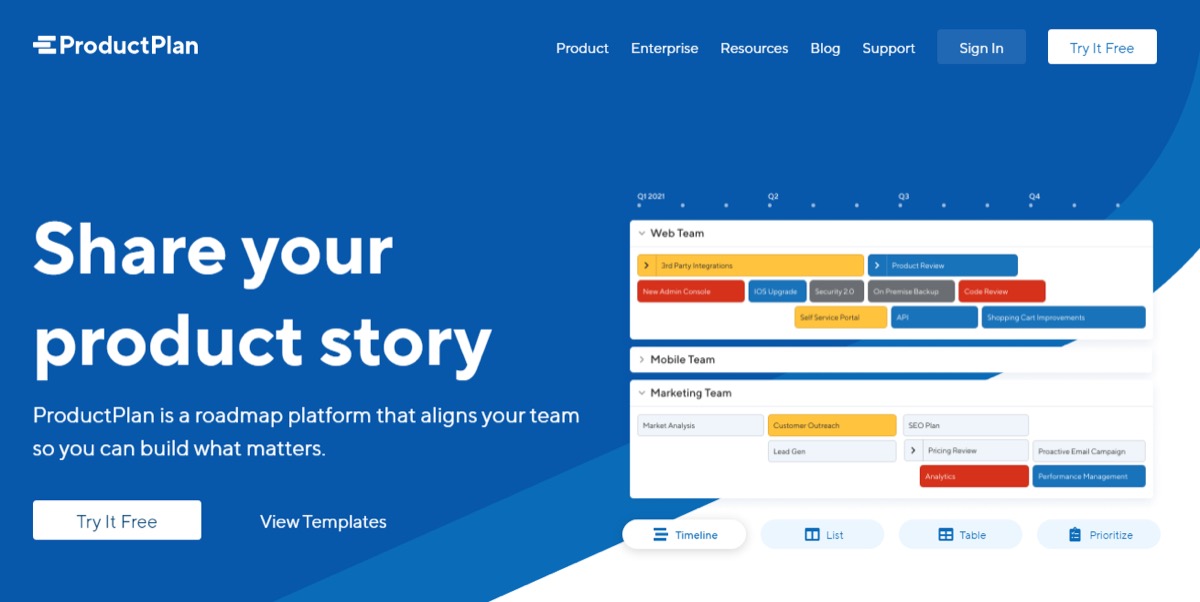
ProductPlan is very similar to ProductBoard in that it allows product managers to create both private and public roadmaps to manage internal alignment and communication with users.
Features
Flexible roadmapping to create and update visual product roadmaps with ease
Roadmap-OKR linkage to align initiatives with strategic objectives
Idea capture and prioritization using custom forms and collaborative tools
Strategic planning views for portfolio-level oversight and goal tracking
Launch dashboard to manage checklists and go-to-market coordination
Customizable workflows to streamline product development across teams
Powerful integrations with tools like Jira, Azure DevOps, Slack, and more
Drag-and-drop interface that simplifies roadmap updates and stakeholder sharing
Pricing
ProductPlan develops custom pricing for each customer account.
Pros and cons
If you're looking for the lowest-cost plan, you'll get more bang for your buck with ProductBoard, but if you're looking for a mid-tier plan with great integrations, then you should opt for ProductPlan.
24. Usersnap
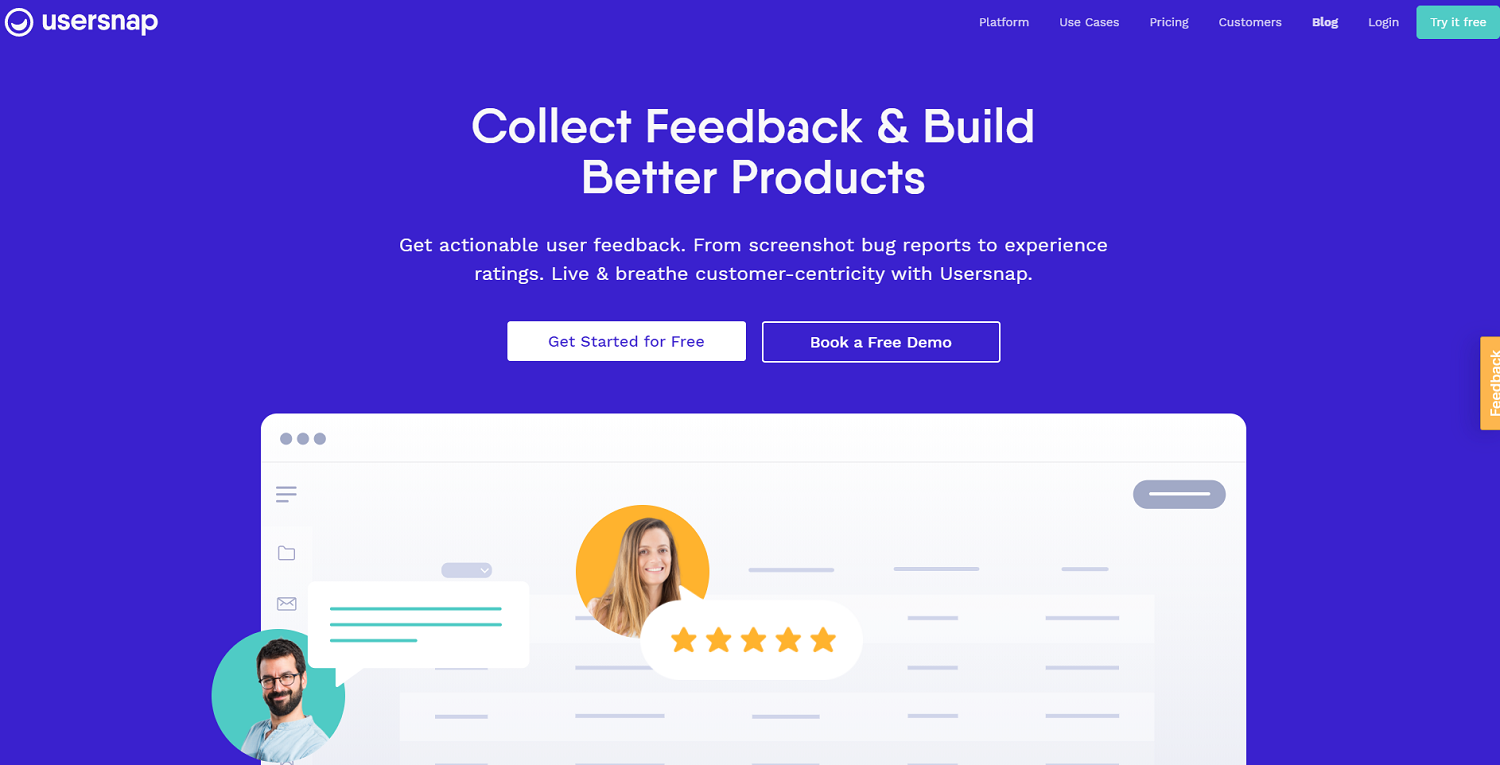
Usersnap is a product feedback software that is trusted by B2B companies, consumer tech companies, and digital publishers. You can collect feedback in a variety of ways.
Features
Visual bug reporting with screenshots and session data
Targeted microsurveys to collect contextual user insights
Feedback widget with screen recording and metadata capture
Changelog widget and in-app announcements for release updates
Feedback hub for centralized triage and prioritization
Sentiment tracking and user satisfaction ratings
Seamless integrations with Jira, Slack, Azure DevOps, and more
Personalized onboarding and top-rated customer support
Pricing
Usersnap offers a free plan with 20 feedback items and no time limit. Paid plans start at $39/month for basic testing and grow to $319/month for advanced features like mobile SDKs, custom branding, and multilingual support. All plans include in-app surveys and screen recordings.
Pros and cons
Usersnap is a great fit if you want to combine product feedback collection, user research, user testing, and CX measurement in one place. The platform is only a fit for collecting feedback on digital products, content, and websites, however.
25. Aha!

Features
Visual roadmapping to align strategy with execution
Customer interviews and insights via Aha! Discovery
Centralized idea management with voting and prioritization
Whiteboard collaboration for brainstorming and early planning
Knowledge bases for sharing product documentation
Agile development tools to link strategy to delivery
Real-time progress tracking and reporting
AI-powered search and insights across the product suite
Pricing
Keep in mind that you'll need to purchase different products (namely Aha! Ideas and Aha! Roadmaps) to get the features described here. Aha! Ideas starts at $39 per user per month and Aha! Roadmaps starts at $59 per user per month.
Pros and cons
Aha! does offer some advanced features, such as the automated feedback analysis, but it does cost a lot more than other feedback collection and roadmap software on our list, so only choose it if you need the extra features.
Market research tools
Brands use market research tools to gather relevant and accurate data through surveys and other tactics. You can use the data to understand your target audience and how to create products that win them over.
26. Veylinx

Unlike other market research tools, Veylinx goes beyond leveraging surveys to gain customer insights. The tool uses transactional learning to forecast consumer behavior, enabling you to satisfy user needs before customers even realize they have such needs.
Features
Transactional testing that measures real purchase behavior
Idea screening to identify high-potential innovations
Concept testing for validating product, branding, and claims
Price testing to reveal optimal pricing strategies
In-home usage testing with pre- and post-trial demand analysis
Custom research solutions for unique business questions
Pricing
Veylinx’s pricing information is not publicly available, but you can contact sales for a custom quote.
Pros and cons
Usersnap is great if you want to combine feedback collection, user research, user testing, and CSAT measurement. Keep in mind that the platform is only a fit for feedback on digital products, content, or websites, however.
27. Resonate
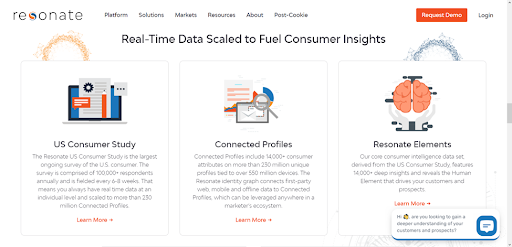
Resonate is an AI-powered platform that gathers user data, analyzes it, and provides easy-to-understand reports. You can use the recommendations in the report to improve your product and better serve your users.
Features
AI-powered consumer profiles covering 250M+ US individuals
15,000+ predictive behavioral and psychographic attributes per profile
Identity graph linking to 1B+ devices for precise cross-device targeting
Dynamic audience insights across the entire customer lifecycle
Enrichment tools to enhance existing data ecosystems and models
Real-time activation of audiences across digital channels
Performance measurement with feedback loops for continuous improvement
Easy-to-use Ignite Platform for discovery, analysis, and action
Pricing
You can contact Resonate to request a demo and custom quote.
Pros and cons
Resonate is a great fit if you're looking to take your feedback collection to the next level with AI. But this platform is only designed for enterprises and is focused more on marketers than product managers or innovators.
Which product feedback software tool is the best?
Every product feedback software tool has unique advantages and disadvantages. Pick the right tool for your company by selecting one that fits your budget and offers the features needed to gather the insights you need. For example, if you need user feedback from people using your app, getting a product feedback tool that only integrates with websites will be a waste.
Frill is one of the best tools for gaining customer insights because it’s user-friendly, scalable, and versatile. You can integrate it with your app or website or use the standalone web platform.
Frequently asked questions
What are the most basic features a small business needs in a product feedback tool?
A small business needs a product feedback tool with an intuitive idea board, status updates to close the loop, simple prioritization options, changelog publishing, and a user-friendly voting system. Email notifications and widget integration help capture insights seamlessly, while keeping users informed and engaged throughout the product development process.
What advanced features do enterprises need in product feedback software?
Enterprises need advanced features like granular user permissions, multi-brand or workspace support, user segmentation, and custom statuses. Integration with CRMs and analytics tools is essential for aligning feedback with customer data. Enterprises also benefit from API access, custom domains, SSO, and automated workflows to scale product feedback processes while maintaining control, security, and flexibility.
Collect customer feedback for your SaaS app by starting a free trial of Frill today.